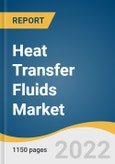The global heat transfer fluids market size is projected to reach USD 14.2 billion by 2030., registering a CAGR of 3.6% during the forecast period. The growing demand from the manufacturing and energy sectors is expected to drive the global market. Thermal oils are typically formulated from petrochemicals and mineral oils, which eventually harm the environment in terms of recyclability, biodegradability, and aqueous toxicity. Due to multiple strict regulations laid down by governments across the globe, the growth of heat transfer fluids (HTFs) has taken a hit.
Major innovators in the field are trying to bring imminent changes in the production process, such as the usage of bio-based products, increased extraction efficiency, and enhanced solvent recovery. The COVID-19 pandemic caused serious disruption in businesses and supply chains. The decrease in supply and demand for oil & gas, especially in North America and Europe, halted the onshore and offshore production processes, impacting the market growth. Food-grade HTFs are widely used for storage and refrigeration applications. With rising precision in temperature control in the processing of food and beverages, thermal fluid systems are gaining acceptance in upcoming food processing plants and facilities.
These products are highly preferred due to lower maintenance costs and low-pressure requirements in the processing facility. Asia Pacific is estimated to be the fastest-growing regional market from 2022 to 2030 due to the rising demand from China and Japan. Rapid industrialization and the development of new machinery have increased the importance of HTFs. Investments in renewable energy initiatives, such as CSP, are expected to have a positive impact on industry growth. For example, in January 2022, China announced to start and complete 11 CSP projects by 2024.
This product will be delivered within 1-3 business days.
Major innovators in the field are trying to bring imminent changes in the production process, such as the usage of bio-based products, increased extraction efficiency, and enhanced solvent recovery. The COVID-19 pandemic caused serious disruption in businesses and supply chains. The decrease in supply and demand for oil & gas, especially in North America and Europe, halted the onshore and offshore production processes, impacting the market growth. Food-grade HTFs are widely used for storage and refrigeration applications. With rising precision in temperature control in the processing of food and beverages, thermal fluid systems are gaining acceptance in upcoming food processing plants and facilities.
These products are highly preferred due to lower maintenance costs and low-pressure requirements in the processing facility. Asia Pacific is estimated to be the fastest-growing regional market from 2022 to 2030 due to the rising demand from China and Japan. Rapid industrialization and the development of new machinery have increased the importance of HTFs. Investments in renewable energy initiatives, such as CSP, are expected to have a positive impact on industry growth. For example, in January 2022, China announced to start and complete 11 CSP projects by 2024.
Heat Transfer Fluids Market Report Highlights
- Silicone-based products are anticipated to exhibit a CAGR of 4.0% from 2022 to 2030 owing to the rising application scope in the oil & gas and chemical manufacturing sectors.
- The consumption of HTFs in pharmaceuticals accounted for a significant market share in 2021 due to its application in extraction and crystallization processes.
- The demand for monoethyl-based glycols in HVAC applications is expected to exhibit a considerable CAGR from 2022 to 2030 owing to their compatibility across wide temperature ranges.
- Asia Pacific dominated the market, in terms of revenue, in 2021 due to the high demand from emerging countries, such as India, Indonesia, and Thailand.
- The Central & South America market is expected to register a steady CAGR from 2022 to 2030 owing to changing political dynamics.
- Moreover, rising automobile production in the region is expected to drive the product demand.
- Eastman company acquired Marlotherm HTFs manufacturing assets in April 2019 to assist the former company in expanding its customer base and heat transfer product portfolio.
This product will be delivered within 1-3 business days.
Table of Contents
Chapter 1 Methodology and Scope
Chapter 2 Executive Summary
Chapter 3 Market Variables, Trends & Scope
Chapter 4 Heat Transfer Fluids Product Outlook
Chapter 5 Heat Transfer Fluids Application Outlook
Chapter 6 Heat Transfer Fluids Market: Regional Estimates & Trend Analysis
Chapter 7 Heat Transfer Fluids Market: Competitive Analysis
Chapter 8 Company Profiles
Companies Mentioned
- Dynalene, Inc.
- Indian Oil Corporation Ltd. (IOCL)
- KOST USA, Inc.
- Hindustan Petroleum Corporation Ltd. (HPCL)
- Delta Western, Inc. (DWI)
- British Petroleum (BP)
- Huntsman Corporation
- Royal Dutch Shell Plc
- Eastman Chemical Company
- Phillips 66
- Chevron Co.
- BASF SE
- Exxon Mobil
- DowDuPont Chemicals
- Dalian Richfortune Chemicals Ltd.
- GJ Chemical
- Radco Industries Inc.
- LANXESS AG
- Schultz Chemicals
- Sasol Limited
- Evermore Trading Corporation
- Tashkent Industrial Oil Corporation
- Shaeffer Manufacturing Co.
- Paras Lubricants Limited
Methodology

LOADING...
Table Information
| Report Attribute | Details |
|---|---|
| No. of Pages | 1150 |
| Published | April 2022 |
| Forecast Period | 2022 - 2030 |
| Estimated Market Value ( USD | $ 10.6 Billion |
| Forecasted Market Value ( USD | $ 14.2 Billion |
| Compound Annual Growth Rate | 3.6% |
| Regions Covered | Global |
| No. of Companies Mentioned | 24 |









